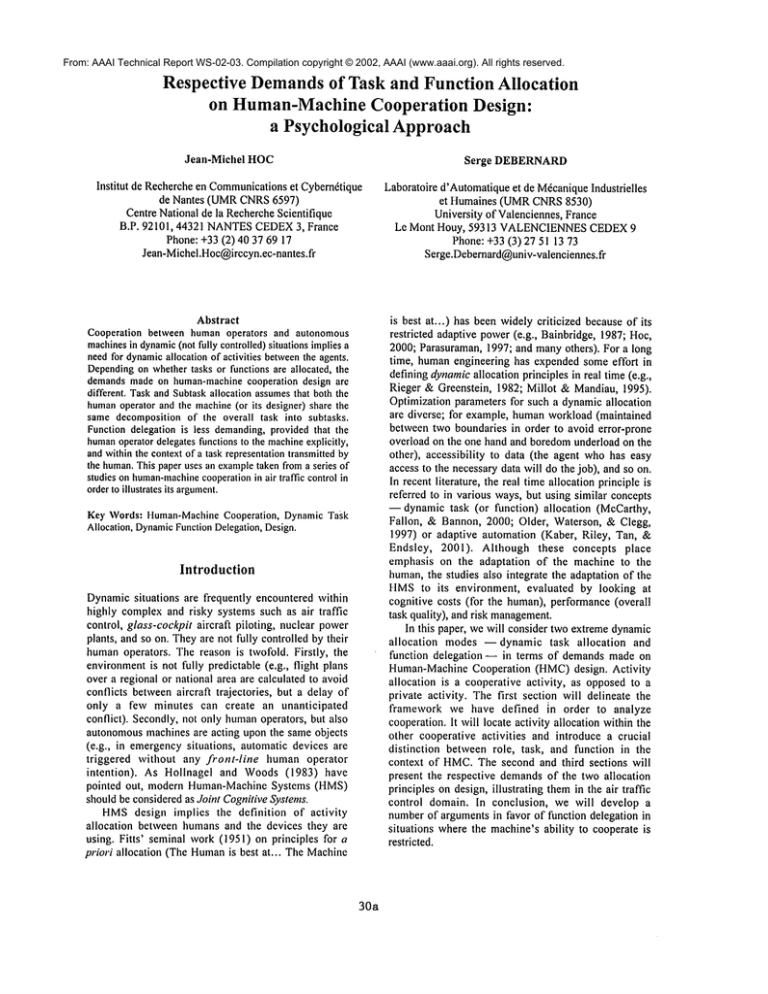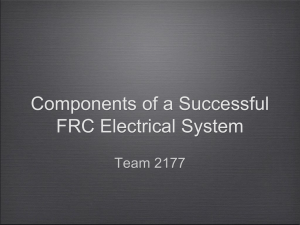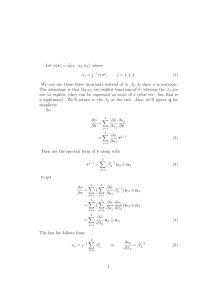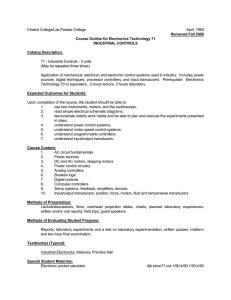
From: AAAI Technical Report WS-02-03. Compilation copyright © 2002, AAAI (www.aaai.org). All rights reserved.
Respective Demandsof Task and Function Allocation
on Human-MachineCooperation Design:
a Psychological Approach
Jean-Michel
HOC
Serge
Institut
de Recherche en Communicationset Cybern6tique
de Nantes (UMRCNRS6597)
Centre National de la RechercheScientifique
B.P. 92101, 44321 NANTESCEDEX3, France
Phone: +33 (2) 40 37 69
Jean-Michel.Hoc@irccyn.ec-nantes.fr
Abstract
Cooperation between human operators and autonomous
machinesin dynamic
(not fully controlled)situations implies
needfor dynamicallocation of activities betweenthe agents.
Depending
on whethertasks or functions are allocated, the
demandsmade on human-machinecooperation design are
different. Taskand Subtaskallocation assumesthat both the
humanoperator and the machine(or its designer) share the
same decomposition of the overall task into subtasks.
Function delegation is less demanding,provided that the
humanoperator delegates functions to the machineexplicitly,
andwithinthe contextof a task representationtransmittedby
the human.This paper uses an exampletaken from a series of
studies on human-machine
cooperationin air traffic control in
orderto illustrates its argument.
DEBERNARD
Laboratoire d’Automatiqueet de MrcaniqueIndustrielles
et Humaines (UMRCNRS8530)
University of Valenciennes, France
Le Mont Houy, 59313 VALENCIENNES
CEDEX9
Phone: +33 (3) 27 51 13
Serge.Debernard@univ-valenciennes.fr
is best at...) has been widely criticized because of its
restricted adaptive power(e.g., Bainbridge, 1987; Hoc,
2000; Parasuraman, 1997; and manyothers). For a long
time, human engineering has expended some effort in
defining dynamicallocation principles in real time (e.g.,
Rieger & Greenstein, 1982; Millot & Mandiau, 1995).
Optimization parameters for such a dynamic allocation
are diverse; for example, humanworkload (maintained
between two boundaries in order to avoid error-prone
overload on the one hand and boredomunderload on the
other), accessibility to data (the agent who has easy
access to the necessary data will do the job), and so on.
In recent literature, the real time allocation principle is
referred to in various ways, but using similar concepts
--dynamic task (or function) allocation (McCarthy,
Fallon, & Bannon, 2000; Older, Waterson, & Clegg,
1997) or adaptive automation (Kaber, Riley, Tan,
Endsley, 2001). Although these concepts place
emphasis on the adaptation of the machine to the
human,the studies also integrate the adaptation of the
HMSto its environment, evaluated by looking at
cognitive costs (for the human), performance (overall
task quality), and risk management.
In this paper, we will consider two extreme dynamic
allocation
modes I dynamic task allocation
and
function delegation-- in terms of demands made on
Human-MachineCooperation (HMC)design. Activity
allocation is a cooperative activity, as opposed to a
private activity. The first section will delineate the
framework we have defined in order to analyze
cooperation. It will locate activity allocation within the
other cooperative activities and introduce a crucial
distinction between role, task, and function in the
context of HMC.The second and third sections will
present the respective demandsof the two allocation
principles on design, illustrating themin the air traffic
control domain. In conclusion, we will develop a
numberof arguments in favor of function delegation in
situations where the machine’s ability to cooperate is
restricted.
Key Words: Human-MachineCooperation, Dynamic Task
Allocation, Dynamic
FunctionDelegation,Design.
Introduction
Dynamicsituations are frequently encountered within
highly complex and risky systems such as air traffic
control, glass-cockpit aircraft piloting, nuclear power
plants, and so on. Theyare not fully controlled by their
humanoperators. The reason is twofold. Firstly, the
environmentis not fully predictable (e.g., flight plans
over a regional or national area are calculated to avoid
conflicts between aircraft trajectories, but a delay of
only a few minutes can create an unanticipated
conflict). Secondly, not only humanoperators, but also
autonomousmachines are acting upon the same objects
(e.g., in emergency situations, automatic devices are
triggered without any front-line
human operator
intention).
As Hollnagel and Woods (1983) have
pointed out, modern Human-Machine Systems (HMS)
should be considered as Joint Cognitive Systems.
HMSdesign implies the definition of activity
allocation between humans and the devices they are
using. Fitts’ seminal work (1951) on principles for
priori allocation (The Humanis best at... The Machine
30a
case withCastelfranchi’stheory (1998),ours puts at its
core the notion of (negative or positive) interference
(dependence or inter-dependence between different
agents’ goals and subgoals). Weconsider cooperative
activities as being mainlymotivatedby the management
of such interference, in order to facilitate individual
tasks or the overall task (Hoe,2001).
Human-Machine Cooperation
A Theoretical
Cooperation
Framework for
Cognitive
Our approach to cooperation is more process than
structure oriented. It describes cooperativeactivities
(and their underlying representations) and must
complemented
by other approachesin terms of relations
and communicationflows between agents. As is the
~COOPERATIVEACTIVITIES
LEVEL
C~
LEVEL
Local
interference
I
creation I
Maintainance
or elaboration
of a representatior
Local
interference
detection
of the controlled
process
Goal
identification
on the basis of
domain
knowledge
of the control
activity
Local
interference
resolution
)
- Common
goal
- Common
plan
- Function
allocation
METALEVEL
(Maintenance/elaborati¢
Common
communication
code
Compatible I
representation
I
Model
of oneself
and
of the partner
Figure 1: Cooperativeactivities (after Hoc, 2001).
Wedefine three levels of cooperativeactivity in relation
to the temporalspan (or horizon)covered(Figure 1).
the action level, cooperation consists of local
interference management.At the planning level, it
enables the agents to maintain and/or elaborate a
COFOR(COmmonFrame Of Reference), a concept
similar to common
ground (Clark, 1996) or a shared
mental model (Cannon-Bowers,Salas, & Converse,
1993). It is concernedwith the representation of the
environmentas well as the representationof the team’s
activity, andit is an internal representationas opposed
to an external support (Jones &Jasek, 1997). Activity
allocation belongs to the planning level. The metacooperation level integrates long-term constructs,
including "translators" between each partner’s
30b
representations or modelsof oneself, or of the other
agents. The activities that can be foundat each level
enablethe agent to introducean anticipative feature into
the activities situated at the previouslevel. Forexample,
a model of the other agent can facilitate
goal
identification.
Diverseformsof interference are possible. Someof
themhave already been widely studied by artificial
intelligence and psychologyin the domainof planning
(Hoc, 1988) --precondition or interaction between
goals. Others are specific to cooperation (Hoc, 2001)
--redundancy between agents or mutual control (of
each agent over the others’ activities). Redundancy
is
obviouslya necessaryconditionfor activity allocation.
Asfar as HMC
is concerned,mutualcontrol is crucial
since the machine is always supervised by a human
operator and can therefore contribute to the correction
of humanerrors.
The Problem of Activity
Humans and Machines
Allocation behveen
Within the HMCcontext, the use of concepts borrowed
from human-humancooperation is justified because it
has been proved that humanscan transfer cooperative
attitudes to machines (Nass, Fog, & Moon, 1996).
However, to use concepts originated from the study of
human-human
cooperation, without a degree of caution,
in order to approach human-machinerelationships could
be inappropriate. The most debatable is certainly the
notion of role in which there are two components: the
activity and the related responsibility. Role allocation is
possible between humans, but one cannot allocate a
"role" to a machinethat is only able to assumea certain
authority, rather than any responsibility. If an activity is
allocated to a machine, there is always a ’front-line’
humanoperator responsible for this activity. One of
well-documented difficulty
with automation is the
complacency
phenomenon that reduces human
responsibility without replacing it with any ’machine’
responsibility (Hoe, 2000). Certainly, in law, there
always a responsible entity, but it is always of a human
nature (the human designer or the front-line human
operator). Strictly speaking, there is no role allocation
between humansand machines.
The notion of task allocation looks morerealistic in
HMC,
that is to say, it is a goal that can be reached with
some autonomy. The designers have no problem in
performing hierarchical task analyses, decomposing
overall tasks into subtasks, sub-subtasks, and so on,
until they reach elementarylevels. Is putting one foot in
front of the other a task for a walker under ordinary
conditions?
When we are confronted by a human
operator performing what we think of as a task, several
problems can arise. Anoperation such as taking a step
may be considered by the walker to be simply a means
rather than an end. Elaborating a representation of this
particular goal can jeopardize the necessary fluidity of
the walk. Furthermore, when the walker stoops under a
heavy burden, the high level of interaction betweenthe
two operations makes it difficult
for them to be
processed independently. This task decompositionis not
then appropriate for the actual executionof this activity.
We have defended elsewhere (Hoc, 1988) the
importance of the consideration of the subject’s task
representation to an understanding of task execution.
During its execution, a task (or sub-task) can
identified by the representation of a goal as an intention
to be protected (by the performer). Dynamic task
allocation between a humanoperator and a machine (or
another human operator) is acceptable only if the
designer’s overall task decomposition is compatible
with the task decompositionconsidered by the operator.
A weak form of task allocation
is function
allocation, wherehuman’sresponsibility for the overall
21
task is recognized. A particular
function may be
considered, sometimes as a task, sometimes as a means
without any goal in itself,
but just related to a
superordinate goal. A function is more generic than a
task because it can be utilized in the performance of
different tasks. The same set of functions can be
considered within different decompositions of the same
(overall) task. However,dynamicfunction allocation
not acceptable if the humanoperator cannot identify the
function to be allocated. Below, we will discuss
function delegation as a particular function allocation
modewhere the human operator decides to allocate a
function to a machine explicitly, within the framework
of a task decompositiongiven by the human.
An Example: Air Traffic
Control
In France, a research program has been developed to
explore the possible benefits of adaptive automation as
a solution to the yearly 7%increase in air traffic in
Europe (Debernard, Cathelain, Crevits, & Poulain,
2002; Hoc & Lemoine, 1998; Vanderhaegen, Crevits,
Debemard,&Millot, 1994). It has made use of diverse
Automatic Conflict Resolution Devices (ACRD)
dynamically allocate some activities,
either to the
humancontroller or to the ACRD,in order to alleviate
the humanworkload. The distinction we have just made
between task and function applies clearly to this
program.
Figure 2 reproduces part of an air traffic control
radar-like scope. At first, two aircraft (AFR124and
BAW678)
can be identified as conflicting (crossing
the top left under the acceptable separation gap) if
nothing is done. The third one (BAW678) is not
conflicting. Following the usual rule (that governs
relations between the speeds), the (human) air traffic
controller
decides to make AFR124 go behind
BAW456.As soon as this intention is formulated, the
contextual aircraft BAW678
enters into the conflict, in
this instance with AFRI24.A second deviation decision
is madeand the problemis completely solved.
This presentation of the problem is very analytical
as opposedto the representation likely to be elaborated
by human controllers
who use powerful pattern
recognition processes (Klein, Orasanu, Calderwood,
Zsambok, 1993). As a matter of fact, controllers
recognize a three-aircraft conflict immediatelyand the
two-step solution is envisioned straightaway. The first
ACRD
utilized in the experiments was a two-aircraft
conflict resolution device. The task unit represented by
the controllers is not of this kind. The two successive
two-aircraft conflicts are not resolved separately, but as
a means(function applications) of executing the threeaircraft task. In addition, if the device turns AFR124
to
the left in the two-aircraft conflict (AFR124and
BAW678),it can create a more complex problem,
involving several aircraft on the left, than the initial
three-aircraft problem. This analysis also showsthat the
waya task is defined is not independentof intention and
that task decomposition is governed by the reduction of
interference betweensub-tasks.
....
,.. / ........
I
%-..
j
~.--
~.-.’~
.:
~
j "--~
/
, i i’..
I
"-.
/
/
....
-:
!
/
I
I
/
,
/
/
-
#
!
I
i
i
/
/
.:
:
\
%
""
-i
",.
"-
,,,
:.
/
" .e..Aw456/
L
i/
//
/ el
,
i
i
/
/
.."
m
/ ¯
/
/
/
-
~
BAW678
lm~.
.~
\\
-/
Figure 2: Resolution of a three-aircraft
conflict in air traffic control. A square (followed by after-imagery
dots in relation to speed) represents an aircraft.
A thin line represents an airway. Two aircraft
--BAW456 and BAW678-- are going from South-East
to North-West.
AFR124’s trajectory
crosses the others’ trajectories. Bold lines indicates the effect of the deviation instructions given to
the aircraft
DynamicTask Allocation
Implicit and Explicit Allocation
A first version of the platform (simulator and assistance:
SPECTRAV l: Vanderhaegen et al., 1994) was
developed to compare two allocation modes: implicit
and explicit. Only Radarcontrollers (in charge of safety
and expedition in the sector) were employed for night
traffic duty. Planning controllers,
in charge of
regulating the radar controllers’ workload and intersector coordination, were not present. The implicit
modeconsisted of imposing the allocation on the basis
of an evaluation of the radar controller’s workloadand
the maintenance of this workloadbelow a certain level.
In the explicit mode,the radar controller decided on the
allocation.
These two modes were compared with a
control situation where no ACRDwas used. Despite
using an inappropriate experimental design (one that
lacked balancing order effects),
a high degree of
consistency was found between different kinds of
variables (objective and subjective measures). This led
the researchers to drawtwo main conclusions.
The two modes led to a better performance
than the control situation, in correlation with
the numberof conflicts allocated to the ACRD.
Task Definition
DynamicTask Allocation (DTA)assumes that the tasks
(and subtasks) to be allocated, either to the humanor
the machine, can be defined beforehand in a generic
way. This generic definition will then be applied in real
time to identify sub-tasks of this kind, resulting in a
decompositionof the overall task. Moreoften than not,
the definition relies on competency of the automatic
device, since it is crucial to that it can take the place of
the human (redundancy). The first part of the Air
Traflic Control (ATC) research program (SPECTRA)
explored the concept of DTA. It assumed that ATC
controllers could accept DTAwhen two-aircraft tasks
are actually considered (Hoc & Lemoine, 1998;
Vaderhaegenet al., 1994). It was found that the benefits
of using the ACRD
were considerably reduced, because
of a numberof refusals by controllers to allocate (or to
see allocated) two-aircraft conflicts belongingto threeor four-aircraft problems. It was felt that the ACRE)
would render the problem more complex to solve.
Despite this, however, the ACRD
still appeared to be
effective.
32
¯
The implicit modewas better than the explicit
mode, in terms of performance, because the
latter mixedstrategic (allocation) and tactical
(conflict resolution) activities, whichled to
overload. However,despite its positive effect
on performance, the implicit mode was less
appreciated by the controllers than the explicit
mode. They reported that they were very
anxious to keep control over the entire
situation.
A second platform (SPECTRAV2: Hoc & Lemoine,
1998) was developed in order to reduce the explicit
allocation demands. This necessitated two kinds of
controller
--a radar controller
and a planning
controller. Twoexplicit modeswere defined --a fully
explicit modeand an assisted explicit mode. The fully
explicit modeenabled the two controllers to allocate the
conflicts. In the assisted explicit mode, the machine
madea proposal, the planning controller could exert a
veto right, but the radar controller was not in charge of
the allocation. The two modes were compared with a
control situation and the order effects were balanced.
Looking beyond the benefits of the two modes over the
control situation, the main results were as follows
(obviously,
the problem of task decomposition
remained).
¯
The assisted explicit modewas more effective
than the fully explicit mode, in terms of
performance, but also in terms of private and
cooperative activities. Private strategies were
more anticipative, because time was saved by
the ACRD
resolutions (including re-routing)
and the planning controllers’ contribution to
DTA.Cooperative activities (between human
controllers) appeared to be easier to develop,
possibly because of a richer external COFOR
on the interfaces.
¯ However, some evidence of a complacency
phenomenonwas found in the protocols. The
radar controllers could not allocate conflict and
thus felt themselves less responsible for the
tasks performed by the machine.
The Demands of Dynamic Task Allocation
Design
compromise, between the two modes is the
production of proposals, which are then
validated. Howeverthe machine should be able
to produce acceptable proposals on a frequent
basis.
The human responsibility should be retained
within the situation.
The humans should
committhemselves in the allocation process in
order to avoid complacency, that is to say a
split in the supervision field, wherethe humans
only supervise their own action fields.
Consequently,
implicit
DTA should be
avoided.
A mixture betweenstrategic and tactical tasks
should be avoided. There is a compromise to
manage between the human implication in the
allocation and the possible overload.
Dynamic Function
Delegation
Task, Intention and Function Definition
In dynamicsituations, tasks and intentions are defined
in real time. Dynamic Function Delegation (DED)
implies that the humanoperator defines the tasks. The
second step of the ATC program (AMANDA:
Debernard et al., 2002) has led to the design of a new
platform where the two controllers are in charge of
defining tasks, shownas "clusters" of related aircraft
(clicking
on the interface).
The ACRDdoes not
intervene without any imposedtask definition (e.g., the
cluster in Figure 2). Withina task, a function is defined
as an under-specified plan to be fully specified, for
example, "make AFRI24 go behind BAW456"(and
"re-route it as soon as possible" is always implied by
any plan). The machine is then used as a supercalculator to compute an acceptable deviation. If
necessary, the controllers
can introduce further
constraints. If they have not noticed the problem with
the third aircraft (BAW678),the ACRD
tells them that
the plan is not feasible because of this other conflict.
Then, the controllers can add the second plan --"make
BAW678go behind AFR124"-- and receive a final
validation of the solution. DFDtakes place when the
controller orders plan execution.
on
From these SPECTRA
experiments, three conclusions
can be drawn when it comes to designing an efficient
DTAbetweena humanand an artificial agent.
¯
There must be compatibility between task
decompositions. The best results ought to be
attained
by decomposition into almost
independent sub-tasks, considering the human
intentions. If the machineis unable to produce
such an almost independence and to infer
intentions,
DTA cannot
be entirely
satisfactory.
¯
The humancontrol should be maintained over
the situation. Explicit DTAis always the best
and purely implicit DTAshould be avoided. A
The Demands of Dynamic Function Delegation
on Design
This new principle enables a quite simple machine to
cooperate with the controllers without introducing
negative interference
(destroying a correct task
representation, producing newproblems to solve in the
future, etc.). It also enables the machineto participate in
the mutual control
activity
(improving task
representation). Delegating a function is not a strategic
activity since it is fully integrated into the tactical
conflict resolution activity. An evaluation of this
principle is in progress in order to validate the balance
betweenthe developmentof costly attentional activities
33
References
inside what could be routinized activities
and the
benefits of delegation. In comparison with DTA,DFD
is less demandingon machine design since there is no
need for task decomposition and no incompatibility
problems. Humancontrol and responsibility over the
situation
are protected.
Demands on design are
restricted to direct manipulations on interfaces fully
compatible with radar scopes to avoid destroying those
routinized activities that are absolutely necessary in
ATC.
Bainbridge, L. 1987. Ironies of automation. In J.
Rasmussen,K.D. Duncan, and J. Leplat (Eds.), New
technology and human error, 271-284. Chichester,
UK: Wiley.
Cannon-Bowers, J.A., Salas, E., and Converse, S.A.
1993. Shared mental model in expert decision
makingteams. In N.J. Castellan, Jr. (Ed.), Current
issues in individual and group decision making,
221-246. Hillsdale, NewJersey: Lawrence Erlbaum
Associates.
Castelfranchi, C. 1998. Modelling social action for
agents. Artificial Intelligence 103:157-182.
Clark, H.H. 1996. Using language. Cambridge, UK:
CambridgeUniversity Press.
Dearden, A., Harrison, M., and Wright, P. 2000.
Allocation of function: scenarios, context and the
economics of effort. International Journal of
Human-MachineStudies 52:289-318.
Debernard,S., Cathelain, S., Crevits, I., and Poulain, T.
2002. AMANDA
Project: delegation of tasks in the
air traffic control domain. Paper presented at
COOP’02.Antibes, F, June.
Fitts, P.M. 1951. Humanengineering for an effective air
navigation and traffic control system. Washington,
DC: National Research Council.
Hoe, J.M. 1988. Cognitive psychology of planning.
London: Academic Press.
Hoe, J,M. 2000. From human-machine interaction
to
human-machine cooperation. Ergonomics 43: 833843.
Hoe, J.M 2001. Towards a cognitive approach to
human-machinecooperation in dynamic situations.
International Journal of Human-ComputerStudies
54: 509-540.
Hoc, J.M., and Lemoine, M.P. 1998. Cognitive
evaluation of human-human and human-machine
cooperation
modes in air traffic
control.
International Journal of Aviation Psychology 8: 132.
Hollnagel, E., and Woods, D.D. 1983. Cognitive
systems engineering: new wine in new bottles.
International Journal of Man-MachineStudies 18:
583-600.
Jones, P.M., and Jasek, C.A. t997. Intelligent support
for activity management(ISAM):an architecture
support distributed supervisory control. IEEE
Transactions on Systems, Man, and Cybernetics Part A: Systems and Humans27: 274-288.
Kaber, D.B., Riley, J.M., Tan, K.W., and Endsley, M.
2001. On the design of adaptive automation for
complex systems. International
Journal of
Cognitive Ergonomics5: 37-57.
Klein, G.A., Orasanu, J., Calderwood, R., and Zsambok,
C.E. 1993. Decision-making in action: models and
methods. Norwood, NewJersey: Ablex.
McCarthy, J.C., Fallon, E., and Bannon, L. 2000.
Dialogues on function allocation [Special Issue].
Acknowledgements
This research program has been funded by the French
National Research Center on Air Traffic Management
(CENA).
Conclusion
Dynamicactivity allocation and adaptive automation
are both reactions to numerous criticisms of full
automation and illustrates its drawbacks (Hoc, 2000;
Parasuraman, 1997) including: a decrease in the HMS
adaptive power, an increase in risks because of human
complacency about a badly designed machine, and so
on. Certainly there should be continued research into
the design of machines with more know-howand more
ability to cooperate. Complex task decomposition,
intention recognition, and cooperative planning should
also be greatly improved. However, with the present
state of affairs, dynamictask allocation (DTA)remains
difficult to accept in real dynamic situations where
human expertise should be promoted rather than
impoverished or badly advised by narrow-minded
machines. That is why, after having explored DTAin
ATC, we have adopted the best benefit of dynamic
function delegation (DFA).
Now,returning to the main topics of this workshop,
our experience suggests the followings remarks.
¯ The human agent should decide the allocation
(possibly with computersupport).
¯
Intention recognition is needed in task
definition,
but human intentions
can be
transmitted
to the machine at low cost
(schematic plans).
¯
Monitoring (mutual control) can be promoted
in both directions, in other words, not only
from the humanto the machine, but also in the
reverse direction.
¯
Shared knowledge and plan (COFOR)
necessary. As is function delegation within
common problem representations
where
feasible at a low cost.
¯ The machine’s autonomymust be restricted if
it is likely to producenegative interference in
humanactivity.
34
International Journal of Human-ComputerStudies
52(2).
Millot, P., and Mandiau, R. 1995. Man-machine
cooperative organizations: formal and pragmatic
implementation
methods. In J.M. Hoe, P.C.
Cacciabue, and E. Hollnagel (Eds.), Expertise and
technology:
cognition
& human-computer
cooperation, 213-228. Hillsdale,
NewJersey:
Lawrence Erlbaum Associates.
Nass, C., Fogg, B.J., and Moon, Y. 1996. Can
computers be teammates? International Journal of
Human-ComputerStudies 45: 669-678.
Older, M.T., Waterson, P.E., and Clegg, C.W. 1997. A
critical assessment of task allocation methods and
their applicability. Ergonomics40: 151-171.
Parasuraman, R. 1997. Humansand automation: Use,
misuse, disuse, abuse. HumanFactors 39: 230-253.
Rieger, C.A., and Greenstein, J.S. 1982. The allocation
of tasks between the human and computer in
automated systems. Proceedings of the IEEE 1982
International
Conference on "Cybernetics and
Society". 204-208. NewYork: IEEE.
Vanderhaegen,F., Crevits, I., Debernard,S., and Millot,
P. 1994. Human-machinecooperation: toward and
activity regulation assistance for different air-traffic
control levels. International Journal of HumanComp,tterInteraction 6: 65-104.
35






